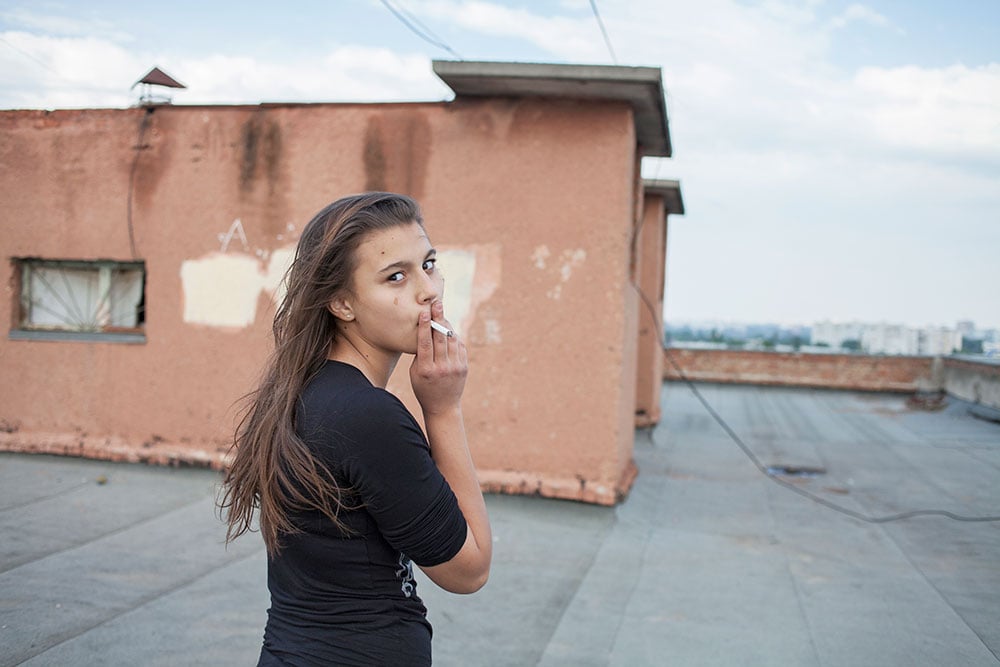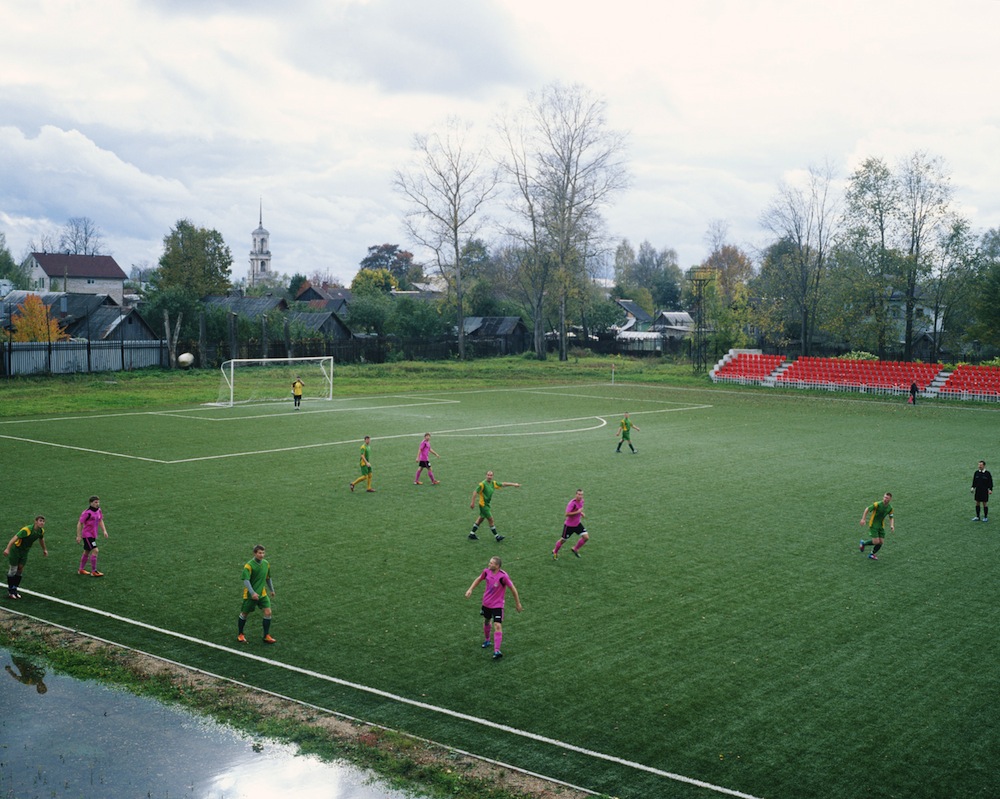How football brought Moldova and Transnistria together, despite 27 years of frozen conflict
In 1992, a brief but bloody war saw the widely unrecognised republic of Transnistria declare its independence from Moldova. Despite 27 years of frozen conflict, the two states do have one thing in common — a shared football league. How has this strange example of co-operation across disputed borders survived for so long?
From the fifth floor of the Butylka museum in the Transnistrian village of Ternovka, the view stretches for miles. Acre upon acre of lush green fields roll out into the distance. To the north-east, the city of Tiraspol sprawls out across the landscape. The jewel in its crown, the Sheriff Arena, sits proudly on the city’s main thoroughfare, Strada Karl Liebknecht.
Two other football stadiums are also visible from the top of the Butylka. Right on the horizon, it’s just possible to make out Dynamo Stadium in the nearby town of Bendery, whilst much nearer, the ground of local club Dinamo Auto-Tiraspol can be seen crisply, just half a kilometre or so up the road.
It is apt that so many football grounds are visible from here. Butylka’s owner, textiles magnate Grigory Korzun, is one of the most important names here — not just in football, but in the troubled history of Transnistria’s relationship with its neighbour Moldova.
It was Korzun who, in the highly delicate aftermath of the 1992 Transnistrian war of independence, successfully lobbied the nascent state authorities in Tiraspol to forgo the founding of a separate Transnistrian football league. Instead, he convinced them to continue working with their Moldovan league counterparts. It was the beginning of a fruitful relationship that has survived for over 25 years.
A monument to football in Chișinău
Preserving this joint league has been one of the most unlikely success stories of the post-Soviet world. Ever since the bloody conflict in 1992 that claimed the lives of nearly a thousand people and left the economies on both sides of the Dniester in tatters, resistance to Chișinău has been the essential fact of Transnistria’s existence.
Moldova’s claim on the land immediately east of the River Dniester traces back to an agreement between the Soviet and Nazi authorities in 1940, which took the Romanian-speaking Bessarabia region away from Bucharest and annexed it to the USSR. Moscow, in turn, incorporated Transnistria, formerly part of Soviet Ukraine, into its newly acquired territory, creating the legally recognised borders of the modern Moldovan republic.
When Moldova former declared its independence from the USSR in 1991, separatist factions in Transnistria considered this a final nullification of the Nazi-Soviet pact; fearful that Chișinău would go on to seek reunification with Romania, they announced their own independence. The 1992 war, fought over a period of four months between March and June, marked the final, deadly attempt by Chișinău to bring Transnistria back under its control.
The footballing union between Moldova and Transnistria is one of the most conspicuous and remarkable examples of successful cooperation between two belligerent states
In 2019, Transnistria governs itself as a separate state. Its currency, the Transnistrian ruble, is obtainable only from banks and exchange points within its borders. Transnistrian flags hang alongside those of the Russian Federation on every street, the hammer-and-sickle motif is ubiquitous, and a militarised checkpoint — complete with passport registration and entry permits — greets visitors as they cross the de facto border with Moldova. In Tiraspol, there is not a glimmer of the Romanian language or Latin script in public use. In the heart of town, a Russian tank sits mounted on a plinth, “For the homeland!” scrawled along one side.
Relationships with Chișinău are frosty. Though most ordinary citizens bear little ill will towards their Moldovan cousins — some even admit to seeing a prosperous future in loose federation with Chișinău — at state level, Moldova continues to assert its dominion over the east bank of the Dniester, with Chișinău accusing the Dniester republic of fostering a lawless black hole of contraband and corruption, with an illegal trade in weapons, drugs, fuel, and even human trafficking propping up the separatist state to this day.
Meanwhile, the current Transnistrian president, Vadim Krasnoselsky, made it plain during his 2016 election campaign that he saw no point in seeking closer ties with Moldova, since the republic’s avowed goal is unification with Russia. Moscow pays massive subsidies each year into Transnistrian pension schemes, as well as providing around 70 per cent of the state budget, and maintaining a 1,500-strong “peace army” within the republic.
Sheriff Tiraspol take on Zimbru of Chișinău in the latter’s second arena in 2016
With the above in mind, the footballing union between Moldova and Transnistria is one of the most conspicuous and remarkable examples of successful cooperation between two belligerent states. Indeed, the Moldovan top flight, the Divizia Nationale, has been dominated for nearly two decades by FC Sheriff Tiraspol from the Transnistrian capital, who boast 17 league titles in the last 19 seasons and have represented Moldova in both the Champions League and Europa League.
Pavel Cebanu has been president of the Moldovan Football Federation (FMF) since 1997. Unsurprisingly, he considers the successful fraternity between football clubs on the left and right banks of the Dniester to be the pinnacle of his administration’s achievements. “That’s not just my victory,” he tells me. “[It belongs to] everyone who works at the federation.”
“There were provocations back in the 1990s. There were attempts to stop us from organising football activity between the two [states]. But there has never been any kind of conflict between fans. Football is for all. It doesn’t matter if you are Moldovan, Russian, Ukrainian.”
It is a feeling reflected across the Dniester. Pavel Prokudin is the president of the Transnistrian Football Federation; he is also a former Prime Minister in the Tiraspol government. Despite his closeness to the political nomenclature here, he has never doubted the expediency of a footballing union. “UEFA doesn’t recognise our football federation,” he says of European football’s governing body. “So instead we have developed a very, very good relationship with the FMF. We talk in one football language. Football is not politics here.”
“The conflict in 1992 wasn’t ordinary people fighting ordinary people,” he continues. “It was politicians who made that war. It was not supported by ordinary Moldovans. My mother is Moldovan. My father is Ukrainian. We don’t have conflict at the everyday level.”
Each year, charity matches take place across the divide between representative teams from Chișinău and Tiraspol to raise money for veterans of the conflict. It reflects a palpable feeling that, for citizens, the standoff that exists at state level is a nothing more than a political construct. Communities on either bank of the Dniester see no contradiction in cooperation.
Fans at a match between FC Dinamo-Auto from Ternovka in Transnistria, and Zimbru
That power of that union was put to the test in March 2003, when the Moldovan national team found itself without a usable stadium in which to play an upcoming European Championship qualifier against the Netherlands. It was decided that the only option open to the FMF was to seek to play the game in Tiraspol. Cebanu admits that their fate was in the hands of the Transnistrian authorities: “It needed government approval, or else it could never have happened.”
The green light came, and for the first time ever the Moldovan national team played a game on Transnistrian soil. Despite initial uncertainty over whether it would be possible for the national anthem to be played or for the Moldovan tricolor to be displayed, the match went off without trouble, and a full house at Sheriff Arena roared the team on as they narrowly lost 2-1 to a star-studded Netherlands team.
Fans sing songs and share picnics with the families of the players. It is incredible to think that they have crossed the front line in an ongoing military conflict in order to be here
The journey across the Transnistria “border” is made dozens of times per season, not just by senior professionals travelling for games in Moldova’s Divizia Nationale, but by young families driving their children to play in youth team games between age-group sides.
On a sunny Saturday lunchtime in April, a dozen or so mums, dads, and sisters cheer on the under-14 team of FC Sheriff against their counterparts from FC Zimbru in Chișinău. They sing songs, wave flags, and share picnics with the families of Zimbru players. It is incredible to think that they have crossed the front line in an ongoing military conflict in order to be here.
FC Dacia Chișinău fans in the Sheriff Tiraspol stadium in 2015
Later in the day, the Zimbru first team play at the main stadium against FC Dinamo Auto-Tiraspol, another visitor from across the Dniester. The arena holds over 10,000, but scarcely 500 are here for the game. 14-storey apartment blocks tower over the stadium, casting their communist-era greyness down on the pristinely tailored pitch below. In one corner, a small number of “ultras”, clad in the famous green and yellow of Zimbru, bangs drums and bellow chants, doing what they can to rally some atmosphere in an otherwise silent concrete and plastic amphitheatre.
Emil Pisarenco is chief press liaison at FC Zimbru. He attests to the oneness of spirit felt between football communities on the two banks of the Dniester. “The conflict was politically made,” he says over the thunderous drumming of the ultras. “Ordinary people don’t feel it. But in football, we have had a chance to show the politicians that we can work as one people. And we have taken that chance.”
It is a sentiment codified throughout Moldovan football, right up to its most senior figure, Cebanu. “The union only works in football because it already works in society,” he notes. “Moldovans and Russians and Ukrainians live all across this territory, on both banks. In Georgia and Azerbaijan and Armenia, that is not the case,” he says in reference to other post-Soviet territorial conflicts. “There needs to be co-existence in communities before there can be in sport. We are a calm, hospitable nation.”
Photos are taken from Chiara Dazi’s project The Moldovan Derby, supported by the Brouillons d’un rêve grant from the Société civil des auteurs multimédias (SCAM).


